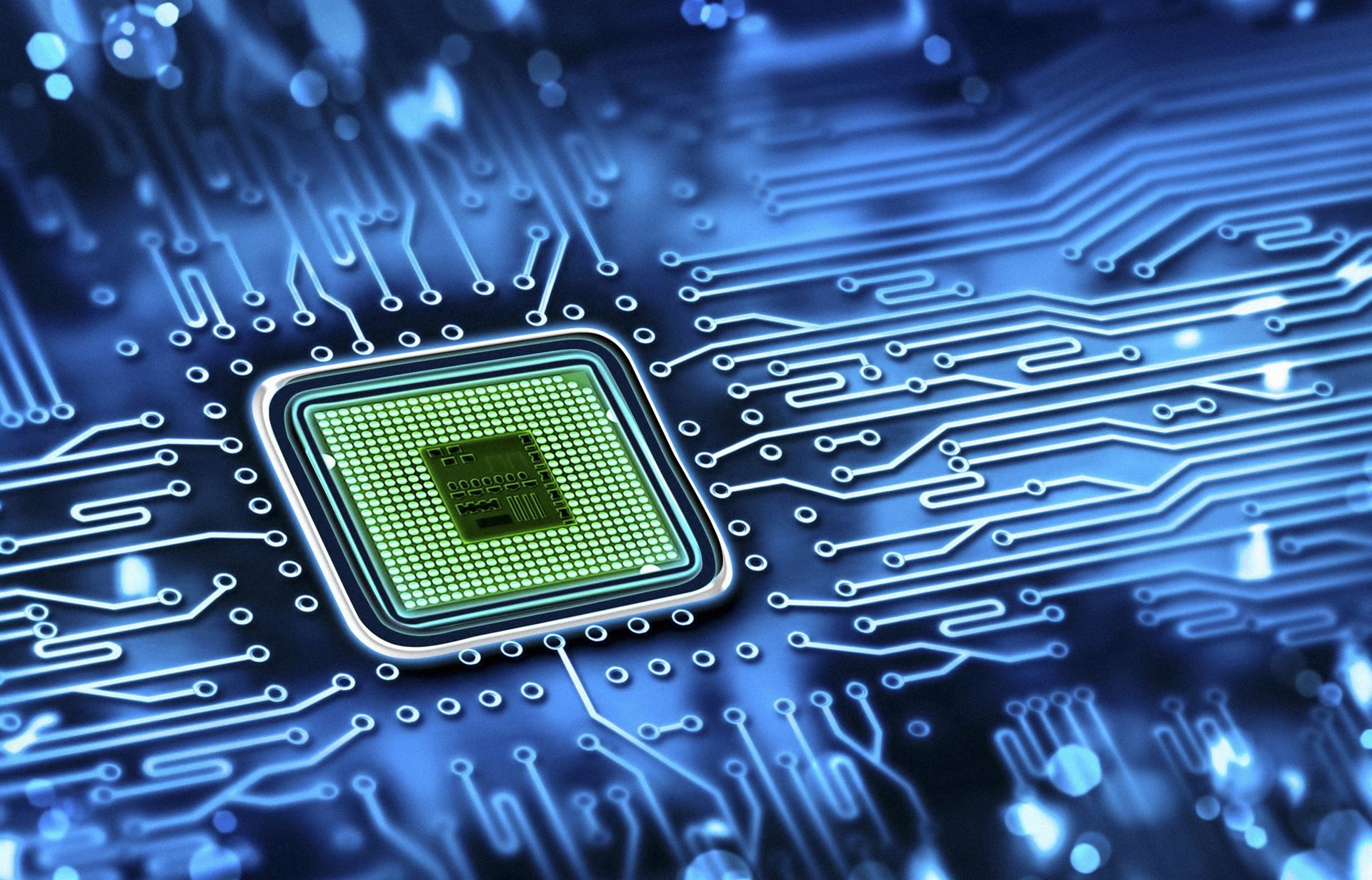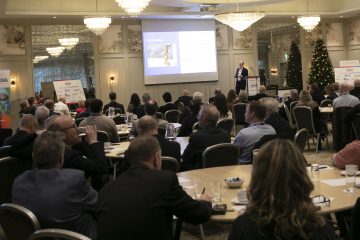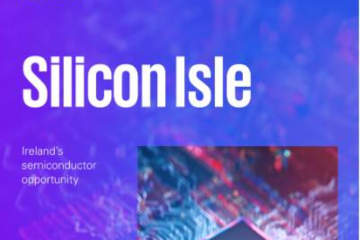With its decades-long track record in semiconductors, Ireland can play a critical role in meeting the industry’s challenges, from supply chain resilience to innovating with new technologies like quantum computing and AI.
Semiconductors are everywhere: as our world becomes more digital, it’s driving up demand for chips which in turn is accelerating moves towards ensuring reliable supply. And as the industry looks to the next wave of expansion, this is where Ireland’s 50-year legacy in electronics manufacturing offers a significant advantage.
Chips are turning up in unexpected places: the average car has anywhere between 300 and 1,000 semiconductor chips while newer electric vehicles can have as many as 3,000 chips in them. Whenever devices from phones to fridges become ‘smart’, the intelligence is powered by embedded semiconductors.
“Semiconductors are behind almost any technology you look at that people are excited about: generative AI, robotics, or autonomous driving,” says Jason Lynch, CEO of Equal1, an Irish-based startup.
Keen to avoid a repeat of shortages experienced during the past few years, the European Union wants to boost production within its territory. In 2023, it passed the EU Chips Act with the goal of doubling semiconductor production within Europe by 2030.
KPMG Ireland believes this legislation will be a catalyst for wider growth, and it projects significant expansion of the market in Europe both in terms of chip demand and, critically for Ireland, chip design and production.
EU Chips Act: opportunities for Ireland
The EU Chips Act could be a significant opportunity for Ireland in areas such as photonics and materials sciences, with specific opportunities to develop competence centres in semiconductors, as defined by the EU Chips Act. “There’s a core strength here already in both of those areas with leading-edge technology already here and significant R&D,” KPMG Ireland says.
A recent report from Tyndall National Institute into Ireland’s semiconductor industry supports this. It pointed to the country’s “significant European prominence, with the continent’s most advanced semiconductor volume manufacturing capability, a legacy node fabrication plant and a strong chip design sector, including major design activities in mixed-signal, automotive, communications and power”.
The EU Chips Act also aims to encourage upskilling of the workforce in the industry.
KPMG notes that this may offer significant opportunities for increased direct and indirect employment. Similarly, the Tyndall report noted the high participation rate of Ireland’s education system which contributes to a steady supply of skills into the industry.
This activity didn’t happen overnight; in fact, Ireland’s semiconductor sector began in 1976 when Analog Devices set up in Limerick, while Intel followed in 1989 by establishing a major manufacturing site in Leixlip, county Kildare.
Today, leading worldwide chip design companies all have significant operations in Ireland. And in the past 12 months, investments by AMD, Analog Devices, Infineon and Qualcomm have led to 1,140 highly skilled new jobs in manufacturing and R&D, at a combined investment of close to €1 billion.
Ongoing investment in chip industry
In 2023, Analog Devices announced a €630 million investment at its Limerick site, which is the company’s European headquarters. AMD invested €124 million into adaptive computing research, development and engineering operations. Qualcomm is putting €140 million into its R&D facility in Cork.
Intel, meanwhile, built upon its €30 billion investment in Ireland by expanding its cutting-edge manufacturing and R&D. In fact, the advanced site referenced in Tyndall’s report is Intel’s Fab 34, supported by a €17 billion investment. It is the first site in Europe to use extreme ultraviolet lithography for mass production. Intel’s extensive Irish operation employs more than 5,000 people.
A broad ecosystem in Ireland
Ireland is also home to three of the top four leaders in electronic design automation (EDA) systems used in the chip design industry: Synopsys, Cadence, and Siemens Mentor Graphics. Other important players in processor IP such as ARM, have operations in Galway.
All told, 15 of the world’s top 30 semiconductor supply chain companies have operations in Ireland, and the microelectronics sector employs more than 20,000 people.
As investment into Ireland grew over time, this activity attracted other supporting organisations and led to initiatives aimed at developing talent for this industry. As recently as February 2024, the Japanese company Pentagon Technologies set up a precision parts cleaning facility in Dundalk to provide specialised services to the semiconductor industry to improve productivity and yield.
Companies looking to internationalise know that Ireland has the advantage of an established ecosystem, available skills at all levels from recent engineering graduates to experienced managerial talent, along with support for the industry from the Government and strong R&D collaboration opportunities.
Feeding the industry demand for innovation
One example of the latter is Tyndall’s work on “the state of the art” to feed the industry’s “constant cycle of innovation to reinvent itself and grow in terms of revenue based on new products,” says Dr Giorgos Fagas, head of the Institute’s Office for EU programmes and the CMOS++ programme for deep tech innovation.
Tyndall’s current project slate varies between looking into macro trends like sustainability, to researching alternatives and substitutes for “forever chemicals” that can be used in the manufacturing processes and in the semiconductors themselves. Tyndall is also investigating new types of computing, memory and materials, as well as looking at how chips can play a role in industries as diverse as healthcare and agriculture.
Tyndall has long-term partnerships with the likes of Intel and Analog Devices. There’s a “push and pull” to those relationships. Sometimes, an industry partner gives specific directions for what it’s looking for. Other times, Tyndall identifies work it knows will match a company’s needs.
Defining research agendas
“We do a lot of pathfinding. We get directions of what to look for and we pick up the signals when the companies speak to us. At the same time, our researchers participate in many working groups defining the strategic research and innovation agendas,” Dr Fagas says.
With a PhD in physics and a decades-long background in nanotechnology, Dr Fagas’ research has been published in more than 80 peer-reviewed articles. He also edited a reference book on molecular electronics and two books on ICT-energy concepts. With this experience, he is well placed to comment on Ireland’s place in the industry. “We certainly are punching much above our weight, not only as a country but as an organisation, as Tyndall is very well regarded in Europe,” he says.
The industry association, MIDAS oversees the continuing talent development through its Electronic Systems Skillnet. Semiconductor companies operating in Ireland also have access to skills through Ireland’s third level education system which is closely aligned with industry needs. University College Dublin (UCD) is the biggest exponent of this in Ireland – one of several.
Developing future industry skills needs
“We’re producing the largest number of students in the country who are specialising in circuit design at everything from bachelors to PhD level,” says Peter Kennedy, Professor of Microelectronic Engineering at UCD.
Like many other institutes and research groups in Ireland, the university isn’t just providing talent; it’s also actively developing intellectual property.
UCD provides consultancy services to many semiconductor companies and licenses technology it develops. “We’re very tightly connected, we have an industry advisory board that shares what the trends are. At the same time, it’s the role of the university to try things that the industry can’t try,” says Prof Kennedy.
As companies scale, their ability and appetite to take risks naturally grows smaller. That creates a space where startups and university research teams can explore new ideas. “You get a lot of innovation coming from small companies that can take risks and also from universities: in terms of what we can try, we are often ahead of where the companies might be, because we can fail where the companies can’t afford to fail. We’re trying the crazy ideas, the ones that are ten years out, then we can start to transition the innovations to industry,” Prof Kennedy says.
One example of this is where Analog Devices needed to design precise frequency synthesisers, the chips that produce radio signals for cellular base stations. The signals needed to be clean but, in the past, there was a problem with unwanted signals of different frequencies that would wander into the communications channels. UCD put a team of PhD researchers to work out the root of the problem.
“We worked on this for a long time to find out the cause: we did a lot of theory, a lot of mathematics, then we could modify the architecture of the chip so it didn’t have this problem. We then licensed the solution to Analog Devices and they put it in a product. That work took ten years,” says Prof Kennedy.
Completing the picture: domestic research centres and startups
Ireland’s semiconductor story encompasses more than the many multinationals successfully attracted to these shores. As well as the names that have landed here through foreign direct investment, there’s also an active cluster of research centres tied to universities, investigating fields like artificial intelligence, nanotechnology, 3D printing, virtual reality and marine science.
Pixapp is leading a European project into a photonics packaging pilot line. Photonics is an innovative technology in photonic integrated circuits (PICs), and packaging is one of the final stages in the semiconductor manufacturing process. Pilot lines are important in R&D so companies can testbed and micro-scale a new chip.
Another player in the Irish photonics space which is gaining a growing reputation is Mbryonics, a spinout from a research team at the University of Galway. It recently won a prestigious contract with the US agency DARPA to develop a critical satellite communications technology on a project to help satellites in the Earth’s orbit to communicate with each other using cutting-edge silicon photonics technology. Or as CEO and co-founder John Mackey puts it succinctly: “We design and manufacture space lasers.”
That neat phrase hides a lot of complexity: as Mackey explains, the telescopes that direct the lasers are mounted on a gimbal because they need to be in constant communication with other satellite towers that are anywhere between 5,000 and 100,000km apart from each other – all while moving at 8km per second in the vacuum of space.
Irish technology powering innovations
The opportunity came about thanks to Mbryonics’ relationship with Intel Program Solution Group (PSG) Ireland, which earlier this year announced it would spin off as a standalone company, Altera. At the time, Intel PSG Ireland had wanted to bid on a DARPA project, and made the initial introductions to the US agency. “DARPA had never heard of us. They were blown away by what we were working on,” says Mackey.
“It’s Irish technology enabling the internet in space and we’re absolutely very proud of it. Between Intel Ireland and Mbryonics, it’s a full end-to-end Irish solution.”
One of the next big breakthroughs for the industry will be the arrival of quantum computing. Far more powerful than current computing, quantum opens up a wide range of sophisticated use cases including pharmaceutical companies carrying out drug testing using quantum computers to mimic a large-scale human trial. Today, it costs pharma companies billions of dollars over many years to bring a drug from research through to approval and public launch.
“We can’t simulate drug development on the world’s largest computers today, even the simplest molecules. Because molecules are quantum in nature, you need a quantum computer to simulate them,” says Jason Lynch of Equal1. Other potential uses for quantum computing include climate modelling, portfolio optimisation in financial services, or managing airline flight logistics more efficiently.
A new way of developing quantum computing
Equal1 aims to make quantum computing widely accessible and has developed technology which integrates all elements of a quantum computer onto a single silicon chip. It is a ‘fabless’ company that provides its design to other semiconductor foundries.
Lynch describes the company’s vision as “disruptive” because it doesn’t require the same low temperatures needed for other quantum computers, and its systems are compatible with today’s data centres. Its technology can be integrated into existing chip production lines, with some modifications.
Lynch worked at Analog Devices’ Irish operation before moving into the startup world, and he he believes this ecosystem makes Ireland ideal for experimentation and exploration. “Ireland is a great place for that because there are senior teams here looking at the architecture that’s going to be needed. We have the ability to engage with them and tell them what we’re doing,” he says.
“Quantum computing will be the next wave of growth for the semiconductor industry here in Ireland,” says Lynch. “For me, it’s the idea that Ireland is a small enough community that we can get together and do something meaningful with impact on the global stage.”
Not only can Ireland continue to nurture the skills the industry will need, and it’s supporting R&D activity through research centres and collaboration vehicles like the Microelectronics Circuits Centre (MCCI), Advanced Materials and Bioengineering (AMBER), the Irish Photonics Integration Centre (IPIC), and Connect.
Other supports are available through IDA Ireland which has established a dedicated semiconductor unit to concentrate its efforts. The Irish Government is developing a national semiconductor strategy and recently held a public consultation as part of its moves to take advantage of the opportunities the EU Chips Act will create.
Between cutting-edge applications in AI and quantum computing, and the increasing connectedness of the world around us, the semiconductor industry is evolving – and Ireland is adapting to meet those needs.
IDA Ireland Contact Information | Contact Us | IDA Address Location | IDA Ireland






